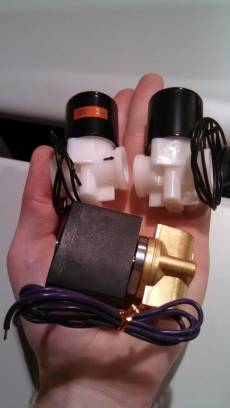atmos:citation:research:mini_ccnc
Table of Contents
Notes related to the Mini-CCNC
Pumps (Rotary Vane, Scroll)
SC1215PM - 0.5 lpm - Website
Clark 15317 - Used in the Telemaster UND UAS package Website
DMT CCN counter uses pump is from KNF Website. The pump is a mini gas sampling pump with double diaphragm system (Model: N838.0).
Orders
Thermoelectric Coolers
Solenoid Valves
Software
- Autocad Inventor
Questions
What approximate flow rate do we need? How do we setup our Watson-Marlow Breded Pump to obtain the necessary flow rate?
How do we easily calculate the activation size of aerosols?
Where can we purchase a thermo-electric cooler that cools water flowing through a 1/4 inch tube?
- Potential Answers:
- TE Tech Liquid (Model numbers indicate capacity rating at 0 degree temperature difference)
- Cools liquid and suited for small heat loads and lab work. Probably the best choice thus far. Roughly 152 x 127 x 96.9 mm. $245. Powered by 12 VDC. Compatible with all TE Tech temperature controllers. LC-035
- LC-061 178 x 127 x 96.9 mm. $302. Powered by 24 VDC. Compatible with all TE Tech temperature controllers.
- LC-200 161 x 216 x 147 mm. $635. Powered by 24 VDC. Compatible with the TC-720 series, TC-36-25 series, and TC-48-20 series temperature controllers.
- If temperature controllers are needed, the following could be used:
- The TC-48-20 can be programmed with the device or can be connected to the keyboard to work with included software (source code included if necessary). TC-48-20 OEM works the same but does not have the keyboard or housing, to lower cost.
- The mechanism through which water is cooled. This is smaller and would be able to work with smaller plate coolers, but would require the additional purchase of a cooler and a heat sink. there is also nothing to indicate whether it is effective at cooling water.
- Questions:
- By how much do we need to cool the water?
- How fast must it be cooled?
- What kind of power source must be used?
- Do we need a specific temperature control? [Yes?]
- How big should the cooler be?
- What should it be made out of?
- How big can it be?
- Do we need a pump?
- Other, less likely answers:
- Another option, but still quite large.
- Tellurex
- Cold plate cooler, Weight 600 grams, operating range -10 to -70 (Celsius), preassembled, includes heat sink. Would need to find a way to attach the tube. $130. PK1 Tellurex Cooler
- SL1210 is similar to the PK1 but can draw more watts at a time, and weighs 895 grams. $215. SL1210 Tellurex Cooler
- TEC1 Coolers are small and compact, and have respectable temperature differentials, but they may have less control over temperature, and would require a separate heat sink. Can be purchased from various places, $3.16-$7.92. (May be less effective since it does not seem to be sold by any specific company. May require more than one.) Higher price, Lower price
- TE Tech
- High temperature models operate at temperatures between -40 and 200 and have dimensions 40 x 40 x 40 mm or less. $15.30-$52.50. Degree of temperature control unknown, and water protection would likely be extra. High Temperature Modules
- Standard models' size varies more, $12-$59. Similar to high temperature, but only operational up to 80 degrees. Standard
- Similar for High Performance High Performance
- Cold Plate coolers with heat sinks are also available, but it works best at lower temperature differences. $169. Cold Plate
- Notes:
- Tellurex has thermoelectric coolers, but there is uncertainty over whether they can cool a 1/4“ tube directly.
- TE Tech has cold plate coolers that could work for cooling a tube of water, but they would likely require an adapter plate.
- Tellurex comes pre-assembled; TE Tech's require assembly.
- TEC Microsystems has a large variety of smaller thermoelectric coolers, but there are no listed prices.
- Thermoelectric liquid chiller/cooler might be an equally viable search term.
- Liquid chillers seem much more bulky and less compact.
- The heat sink will likely be much bulkier than the actual cooler. Plate coolers are generally compact and thin, but the heat sinks cover a larger area and are much thicker.
- Heat sinks are slightly more difficult to find on their own, and are 2-3 inch diameter circles.
Useful TE Tech module calculator Information on Moisture Protection
atmos/citation/research/mini_ccnc.txt · Last modified: 2020/01/29 17:25 by 127.0.0.1
